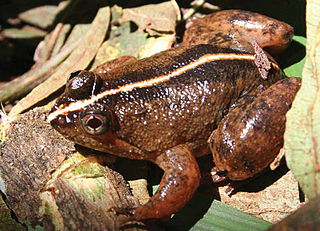
The crab-eating frog is a frog native to south-eastern Asia including Taiwan, China, the Philippines and more rarely as far west as Orissa in India. It has also been introduced to Guam, and was most likely introduced from Taiwan. It inhabits mangrove swamps and marshes and is one of only 144 known modern amphibians which can tolerate brief excursions into seawater.
Rhinella acutirostris is a species of toad in the family Bufonidae. It is found in Brazil, Colombia, Panama, and Venezuela. Its natural habitats are subtropical or tropical moist lowland forests, freshwater marshes, and intermittent freshwater marshes.
Chthonerpeton arii is a species of amphibian in the family Typhlonectidae. It is endemic to Brazil. Its natural habitats are dry savanna, rivers, intermittent rivers, freshwater marshes, intermittent freshwater marshes, pastureland, irrigated land, seasonally flooded agricultural land, and canals and ditches.

The Treasury Island tree frog is a species of frog in the subfamily Pelodryadinae. It is found in New Guinea and the Solomon Islands. Its natural habitats are subtropical or tropical moist lowland forests, subtropical or tropical moist montane forests, swamps, freshwater marshes, intermittent freshwater marshes, rural gardens, heavily degraded former forests, and canals and ditches. It is threatened by habitat loss.
The Zaire forest tree frog, Leptopelis fenestratus, is a species of frog in the family Arthroleptidae endemic to the Democratic Republic of the Congo. Its natural habitats are rivers, freshwater marshes, and intermittent freshwater marshes.
The Nyonga forest tree frog, Leptopelis lebeaui, is a species of frog in the family Arthroleptidae endemic to the Democratic Republic of the Congo. Its natural habitats are rivers, freshwater marshes, and intermittent freshwater marshes. As of 2004, the Upemba National Park was the only place in which they were being protected.

Platyplectrum melanopyga, the Wokan cannibal frog, is a species of frog in the family Limnodynastidae. It is found in New Guinea.
Platypectrum platyceps, the Arfak cannibal frog, is a species of frog in the family Limnodynastidae. It is endemic to West Papua, Indonesia. Its natural habitats are subtropical or tropical moist montane forests, freshwater marshes, and intermittent freshwater marshes.
Fejervarya iskandari is a species of frog that is endemic to Java, Indonesia. It is named in honor of Djoko Iskandar, an Indonesian herpetologist. It has been recorded in Bandung and Sukabumi, West Java.
Fejervarya multistriata is a species of frog in the family Dicroglossidae. It is found in southern China and in Taiwan, but its range likely extends to Vietnam, Laos, Thailand, and Myanmar.
Fejervarya pulla is a species of frog in the family Dicroglossidae. It is endemic to Malaysia and only known from its type locality, Penang Hill. LIttle is known about this species that might even belong to Hoplobatrachus instead of Fejervarya.

The giant Philippine frog, large swamp frog, or Mindanao fanged frog is a species of frog in the family Dicroglossidae. It is endemic to the Philippines. Its natural habitats are tropical moist lowland forests, subtropical or tropical moist montane forests, rivers, intermittent rivers, freshwater marshes, and intermittent freshwater marshes. It is becoming rare due to habitat loss.

The common puddle frog, puddle frog, or yellow bellied puddle frog is a species of frog in the family Dicroglossidae. It has often been confused with Occidozyga sumatrana, and records of this species outside the Philippines likely represent that species.

The Schilluk ridged frog is a species of frog in the family Ptychadenidae. It is found in Angola, Burkina Faso, Cameroon, Democratic Republic of the Congo, Egypt, Eritrea, Ethiopia, Ghana, Kenya, Malawi, Mozambique, Senegal, Somalia, Sudan, and Tanzania. Its natural habitats are dry savanna, moist savanna, subtropical or tropical dry shrubland, subtropical or tropical dry lowland grassland, subtropical or tropical seasonally wet or flooded lowland grassland, rivers, freshwater lakes, freshwater marshes, intermittent freshwater marshes, arable land, ponds, seasonally flooded agricultural land, and canals and ditches.

The common green frog is a frog species of in the true frog family Ranidae; some sources still use the old name Rana erythraea. It lives in Southeast Asia and is also known as green paddy frog, red-eared frog or leaf frog. The last name, however, commonly refers to the Neotropical tree frogs which make up the subfamily Phyllomedusinae. These are not closely related to H. erythraea, belonging to family Hylidae instead.

Hylarana guentheri is a species of frog in the family Ranidae. It was formerly placed in the genus Rana. It is found in China, Hong Kong, Macau, Taiwan, Vietnam, and possibly Cambodia and Laos. An introduced population is found on Guam. An alternate common name is Günther's Amoy frog, and the honorific is often spelled "Guenther's".

The Perez's frog, also known as Iberian waterfrog, Iberian green frog, or Coruna frog is a species of frog in the family Ranidae. It is native to southern France, Portugal, Spain, and has been introduced to the Canary and Balearic Islands, Madeira, the United Kingdom, and the Azores. In the Iberian Peninsula it is widespread and common.
Zhangixalus dorsoviridis, also known as the green-back treefrog, is a species of frog in the family Rhacophoridae that is found in northern Vietnam and southern China (Yunnan). It may be confused with Rhacophorus nigropunctatus. Its natural habitats are subtropical or tropical moist montane forests, freshwater marshes, and intermittent freshwater marshes. It is threatened by habitat loss.
Zhangixalus duboisi is a species of frog in the family Rhacophoridae found in China and Vietnam. Its natural habitats are subtropical or tropical moist montane forests, freshwater marshes, intermittent freshwater marshes, and heavily degraded former forests. It is threatened by habitat loss.

Minervarya nilagirica, commonly known as Nilgiris wart frog, or Nilgiris frog, is a species of frog that is endemic to India.











